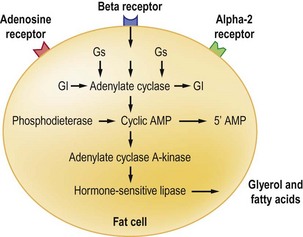Chapter 52 Mesotherapy for body contouring and cellulite
• Mesotherapy is a specialty that is practiced worldwide by over 18 000 physicians for cosmetic applications such as cellulite, spot weight reduction and facial rejuvenation.
• Mesotherapy uses combinations of homeopathic and pharmaceutical medications as opposed to injection lipolysis, which uses a single substance.
• Patient selection is key for success.
• Medication used must be isotonic, biocompatible and sterile, with a pH between 5 and 7.
• Number of treatments is determined by patient’s severity of symptoms and how they respond to therapy.
• Absence of double-blind studies has caused the United States medical community to be slow in its acceptance.
Introduction
Mesotherapy is a nonsurgical cosmetic treatment invented by Michael Pistor in France in 1952 after he completed research in intradermal therapy and research in treating disorders in the mesoderm layer.1 By choosing mesotherapy, the patient is not subjected to oral or intravenous medication, as it treats the problem at its source by local action. The French Academy of Medicine recognized mesotherapy as a specialty of medicine in 1987. The International Society of Mesotherapy has members in 14 countries throughout Europe and South America. Over the past 50 years, in excess of 18 000 physicians worldwide have used mesotherapy on a daily basis for a variety of purposes, including treatment of cellulite, spot weight reduction, overall weight loss, hair loss, facial rejuvenation, correction of liposuction errors, pain management, and sports injuries. This chapter will only deal with the cosmetic applications of mesotherapy for body contouring and cellulite.2
Mesotherapy employs multiple injections of a combination of homeopathic and pharmaceutical medication, plant extracts and vitamins that are injected into the mesoderm layer targeting the adipose fat cells, dermal vasculature, and connective tissue septae. The medications selected for use are based on the intent of the treatment. Injection lipolysis (Fig. 52.1) using a single substance like Lipodissolve™ should not be confused with mesotherapy that uses combinations of medications.3 The injections are performed with a special needle that varies from 0.4 to 0.6 cm, spaced approximately 1.5–2.5 cm apart. Sometimes the technique of Nappage is used; this is a series of injections of small amounts of substance into superficial concentrated areas of the skin with a longer needle up to 13 mm used occasionally to target deeper fat.3
Mesotherapy has spurred some controversy in the American medical community even though it has been very well accepted in Europe and South America.4 Unlike recognized FDA-approved cosmetic procedures, the medications used are off-label and no double-blind studies have been completed to support mesotherapy as an effective nonsurgical alternative to liposuction. Success rates vary on the formulas used, and most users keep their formula proprietary. It is safe to say that mesotherapy should only be utilized by practitioners that are licensed to use injectable medications, and have studied the techniques and complications of the procedure.5
Selection of Patients for Mesotherapy
Cellulite can also be treated with mesotherapy. Cellulite refers to the appearance of dimpled skin referred to as “orange peel”, on the thighs, buttocks, and sometimes lower abdomen of otherwise healthy patients; 90% of cellulite cases occur in women.6 Cellulite is most common in areas of fat deposits and is the result of the unevenness of this fatty tissue beneath the skin surface. Since cellulite is largely due to a structural aberration below the skin, people who have more fat deposits have more pronounced cellulite. Most structural changes include vertical orientation of the septae with increased septal thickness, while those with less fat and more muscular definition tend to have less visible cellulite. There is still much controversy over the etiology and pathology of cellulite. Most theories postulate this condition with abnormal connective tissue organization, alterations in fat metabolism, microcirculatory/lymphatic derangements, and venous insufficiency.7
According to studies conducted using magnetic resonance imaging and sonography,8 female fat lobules are larger than males’ and compartmentalized by fibrous septae that form radial and archlike structures. The uppermost layer of subcutaneous fat has been described as “standing fat-cell chambers” separated by connective tissue. From these fat-cell chambers, small projections of fat cells protrude into the dermis. This unevenness and irregularity of the subcutaneous fat give the skin the appearance we call cellulite.
Mesotherapy treatments for cellulite attempt to improve these four pathological aspects. Medications are selected to improve lymphatic and venous drainage, improve the connective tissue characteristics, and reduce adipose deposits that result in the dimpled look of the skin.9 Although fat reduction is important in the treatment, usually the appearance is of most concern to the patient, rather than a size change of the area.
Patients should be given full counseling on adding exercise and nutritionally sound diets to their daily routines if they are not already adhering to them. Alcohol consumption should be at a minimum, as should UV exposure for suntanning. Sun burn, concurrent skin treatments in the area, or skin infection will contraindicate treatments. Patients should not expose their skin to tanning, jacuzzis or steam following their treatments. Hot showers or baths should also be avoided for 48 hours. Exercise also should be avoided for 8 hours if excessive sweating occurs (Table 52.1).10
TABLE 52.1 Liposuction Versus Mesotherapy
| Liposuction | Mesotherapy |
| Surgical procedure | Noninvasive procedure |
| Removes fat cells | Removes fat from fat cells |
| Cannot be used where there is cellulite | Used wherever there is cellulite |
| Down time (2 weeks) | No down time |
| Wear restrictive garments afterwards for weeks | Wear loose clothing after treatment |
| Weight gain back in abnormal places | Weight gain back where it was lost |
| Significant bruising & pain | Minimal bruising and pain |
| Causes divots and scarring | Reduces divots and scarring |
| Takes up to 3 months to see results | Results seen in weeks |
| Causes loose and weak skin | Tightens and strengthens skin |









